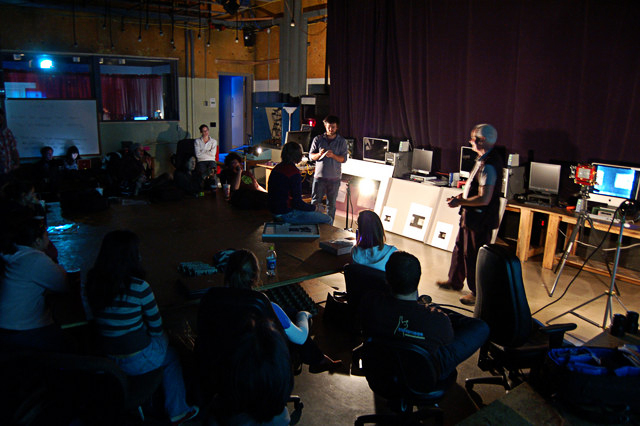| |
| home |
| project two |
| final project |
| references |
| index page |

*mad props to joey and his photographin' skills.
understanding photography as technology "what we call "photography" is a technology. More accurately, it is a branching family of technologies, with different uses, whose common stem is simply the physical marking of surfaces through the agency of light and similar radiations." "Photography is technology by which light is directed to make physical states that we call images. Our sources neglect to state what such "images" are." -Patrick Maynard, The Engine of Visualization With this project, I wanted to use a number of photographic technologies (veiw camera, film, drum scanner, flatbed scanner, inkjet printer, inkjet transparency film, traditional black and white, "wet" darkroom, polaroid film, etc) to breakdown and reconstruct a "photographic image" in order to challenge (or disrupt) the construction of photographic truth. A photograph is not sufficient evidence by itself to represent any whole truth about the moment it depicts. This debate has been exhausted in the world of academia, but remains virtually unknown outside of it. By breaking down this photographic image, one which is quite ambiguous, through a number of branchinng technologies in the "photo-technology tree", I want for it to be impossible for the viewer not to question the validity of its construction and meaning. Hopefully, the viewer will begin to question all of the images they see, which therefore disrupts the hegemonizing effect that has been with the medium since its invention.
|
"default mode of contemporary photography:" MARCO BREUER: "I was looking for alternatives to the default mode of contemporary, which is now a 4 x 5-inch color negative, whether portrait or typology, blown up to 30 x 40 inches or larger and mounted behind plexi. That's the current orthodoxy, one that I experienced in Germany and continue to question." -Blind Spot, issue thirty six
|
breakdown of the series
FIRST GENERATION: the "default" 30 x 40-inch color print
file size: 388 MB, RGB 16-BIT resolution: 300 PPI dimensions: 30" x 38"
SECOND GENERATION: the re-sampled and resized black & white positive & negative
file size (negative): 7.4 MB, RGB 16-BIT resolution: 400 PPI dimensions: 3.625" x 4.625"

SECOND GENERATION SILVER GELATIN PRINTS: the result of contact printing and enlarging the inkjet negative in a "wet" black & white darkroom
dimensions: 4" x 5" (contact print) 8" x 10" (enlargement)
THIRD GENERATION MASTER SCAN: interpolation of the 8 x 10-inch enlargement print using a flatbed scanner.
file size: 2.58 GB, RGB 16-BIT resolution: 2,400 PPI dimensions: 8" x 10"
THIRD GENERATION INKJET NEGATIVE: resolution decreased by half
file size: 4.6 MB, RGB 16-BIT resolution: 200 PPI
THIRD GENERATION SILVER GELATIN PRINTS: printed just like the second generation
dimensions: 4" x 5" (contact print) 8" x 10" (enlargement)
FOURTH GENERATION MASTER SCAN: interpolation in RGB 8-bit of the 8 x 10-inch enlargement print using a flatbed scanner.
file size: 1.37 GB, RGB 8-BIT resolution: 2,400 PPI dimensions: 8" x 10"
FOURTH GENERATION INKJET PRINT: the master scan re-sampled, resized and blown-up
file size: 502.9 MB, RGB 8-BIT resolution: 300 PPI dimensions: 40" x 50"
FIFTH GENERATION POLAROID: digital to analog conversion which breaks the linear progression





